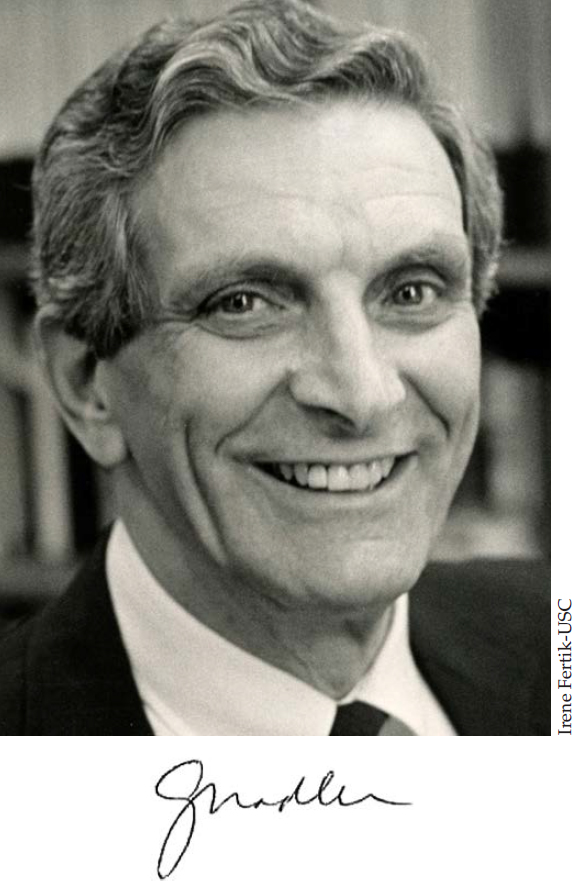GERALD NADLER
1924–2014
Elected in 1986
“For technical and educational leadership in industrial engineering, interdisciplinary systems planning and design methodologies, and for technological literacy programs for non-engineers.”
BY STAN SETTLES
GERALD NADLER, a long-term link to the founders of industrial engineering, including Lillian Gilbreth, passed away at home on July 28, 2014, at the age of 90.
Gerry, as he was generally called, was born in Cincinnati on March 12, 1924, to Samuel and Minnie Nadler. He worked in his father’s retail stores at a young age before earning his BS degree in mechanical engineering in 1945, and MS and PhD degrees in industrial engineering in 1946 and 1949, all from Purdue University.
He began his professional career as a plant industrial engineer at Central Wisconsin Canneries before moving on to positions as vice president for general operations at Artcraft Manufacturing, member of the board of directors for Intertherm Co., and dozens of consulting assignments. He was an instructor at Purdue, professor and department chair at Washington University, University of Wisconsin–Madison, and the University of Southern California (USC), and served in five visiting professorships, four of them foreign.
In his 10 years (1983–1993) as chair of the Daniel J. Epstein Department of Industrial and Systems Engineering in USC’s Viterbi School of Engineering, he brought stability and stature to the department that helped lead to its current status as one of the premiere departments in the discipline. He was appointed
the university’s first IBM Chair in Engineering Management and held that distinction until he retired. He also received USC’s Faculty Lifetime Achievement Award and Phi Kappa Phi Faculty Recognition.
Gerry served on three advisory boards in planning and design methods and management, was president of the Institute of Industrial and Systems Engineers in 1989, and received its highest distinction, the Frank and Lillian Gilbreth Industrial Engineering Award. He chaired four national conferences, delivered over 900 lectures and keynote addresses, received over 25 national and international awards, and authored 15 books and more than 225 articles. His book Breakthrough Thinking: Why We Must Change the Way We Solve Problems, and the Seven Principles to Achieve This (with coauthor Shozo Hibino; Prima Publishing & Communications, 1989) has been translated into ten languages and is cited regularly.
He was a fellow of the Institute of Industrial Engineers, Institute for Operations Research and Management Sciences, American Association for the Advancement of Science, and American Society for Engineering Education; and member of the Institute of Electrical and Electronics Engineers (IEEE) Engineering Management Society, Academy of Management, Institute for High-Performance Planners, and World Future Society.
At the local level Gerry jumped at the opportunity to apply his breakthrough thinking approach. He served on the Los Angeles County Quality and Productivity Commission for many years, into his 80s. He also served on the board of directors of the USC Credit Union and was the leading driver of the credit union’s bold step of erecting its own building, which is now a monument to Gerry’s systems engineering thinking and tenacity. He had an exemplary ability to stick to his mission while working well with people with whom he disagreed at the outset of a project.
He was elected to the NAE in 1986 and served on its Advisory Committee on Technology and Society (1988–1991) and subcommittee on Human Resources, Organizations, and the Adoption of Workplace Technologies (1987–1991), as
well as the NRC Naval Studies Board’s Committee on Shore Installation Readiness and Management (1997–1998). He was also deeply committed to his secondary Section 12 (Special Fields & Interdisciplinary Engineering), representing his broad interest in many areas of engineering.
It was clear to Gerry’s coworkers, students, and family throughout his life that he loved his work both at home and at USC. A strong contributor to his longevity was the combination of deep appreciation of technical and managerial concepts and a very active physical life—he played singles tennis very well and kept it up into his 70s. He also enjoyed season tickets to the USC football games as well as theater and concert series in Los Angeles. And he was very committed to his family.
Gerry is survived by his wife, Elaine Dubin Nadler, whom he married on June 22, 1947; sons Robert and Burton and daughter Janice Cutler; eight grandchildren; three great-grandchildren; a great-great-grandson; and his brother Melvin.





